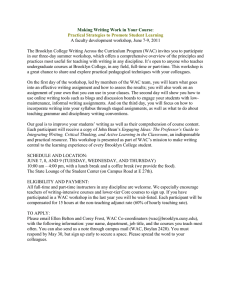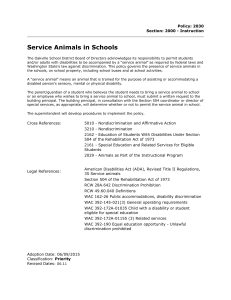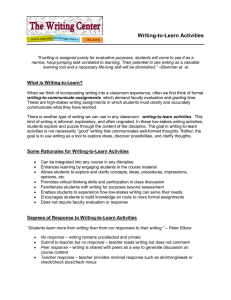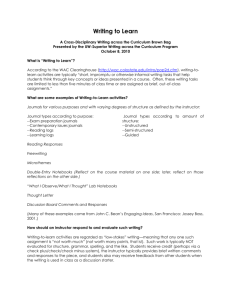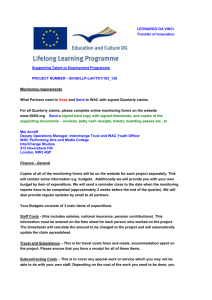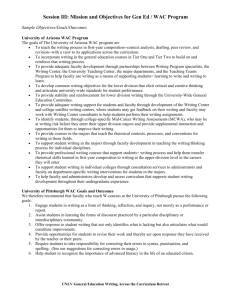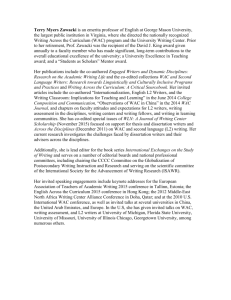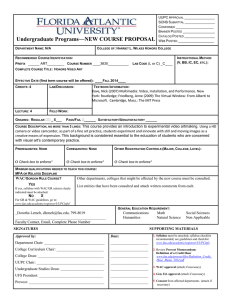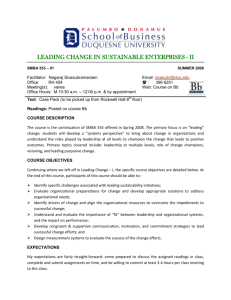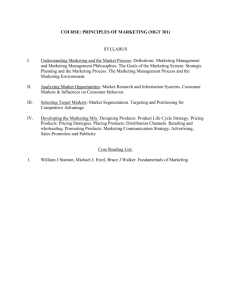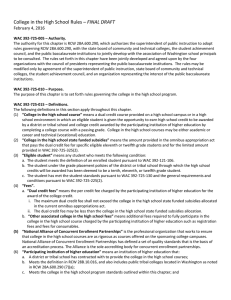Session Two - judithbrookssmith.org
advertisement
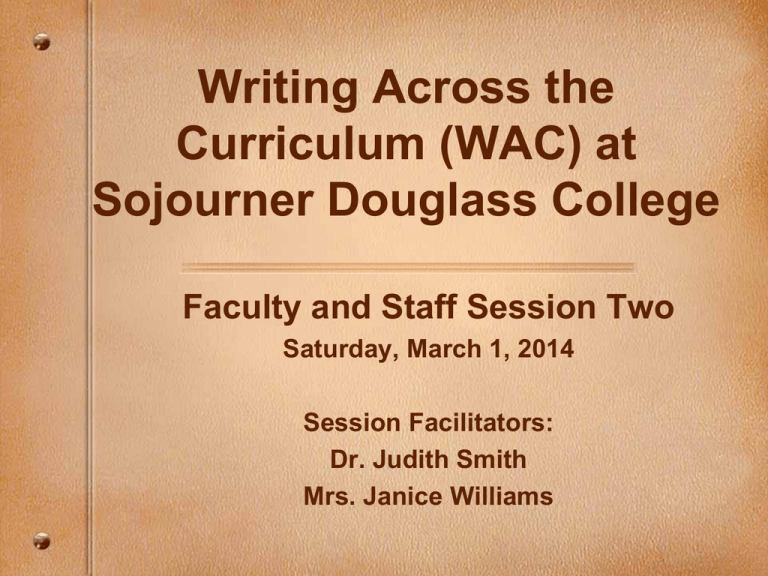
Writing Across the Curriculum (WAC) at Sojourner Douglass College Faculty and Staff Session Two Saturday, March 1, 2014 Session Facilitators: Dr. Judith Smith Mrs. Janice Williams Overarching Question How can we Assist the Adult Learner at Sojourner Douglass College in Mastering Writing Skills While Developing Critical Thinking Skills? Approach for Implementation Design and Implement a College-wide Writing Across the Curriculum Initiative that Integrates Critical Thinking Skills and Meets the Unique Needs of the Students at Sojourner Douglass College. Session Two Goals • Provide a Liaison between Writing Skills addressed in the Common Core State Standards and the Writing and Thinking Skills addressed in the General Education Core Competencies and Major Content Courses • Critique Course Syllabi for Writing Assignments that Incorporate Critical Thinking Skills • Recommend Writing Tasks that Promote Thinking and Learning The Brain and Writing Kolb’s Learning Style Phase Zull’s Neural Networks Suggested Writing Assignment Revisit: Writing Across the Curriculum (WAC) is a Process that • Infuses writing throughout the curriculum for various purposes; • Fosters and demonstrates learning in a variety of disciplines or courses; • Encourages critical thinking and learning; • Uses multiple ways to prepare students for a variety of contexts. WAC Has Two Major Categories Writing-to-Learn Writing-to-Demonstrate-Knowledge Writing-To-Learn… • Fosters critical thinking that requires analysis, application and other higher order thinking skills; • Uses short or informal writing tasks to help students think through key concepts or ideas; • Uses journals, logs, responses to questions, summaries, free writing, and other writing assignments to learn ideas and concepts. • http://www.michigan.gov/documents/mde/Science_WAC_2_3_264454_7.pdf Sensory Cortex Concrete Experience • • • • Watch a Film View a Demonstration Play a Game Conduct Field Observation (David Kolb’s Learning Style Inventory, 1985) Non-Graded Writing Personal writing that records observations, thoughts, and feelings during the initial experience and raise questions and expresses puzzlement (James Zull, Art of Changing the Brain, 2002) Temporal Integrative Cortex Reflective Observation Learners consider the concepts and issues after reading, listening to lectures, participating in class discussions, and hearing different points of view. Personal Exploratory Writing *Journal entries that connect new material to personal experiences and precious knowledge; *Personal pieces based on autobiographical experiences with a topic or concept; *Personal reflective papers that encourage questioning, openended approach rather than thesis-with–support writing. Writing-To-Demonstrate Knowledge • Students synthesize information and explain their understanding of concepts and ideas. • Students write for an audience with a specific purpose. • Students use inquiry-based writing to connect with real-world experiences. http://www.michigan.gov/documents/mde/Science_WAC_2_3_264454_7.pdf Frontal Integrative Cortex Abstract Conceptualization Formal Academic Writing Learners try to achieve abstract understanding of the concepts and issues by mastering and internalizing their components and seeing the relationship between new material and other concepts and issues. Thesis-based analyses and arguments written in an impersonal and dispassionate tone, targeted for a critical and informed audience, based on closely investigated knowledge, and intended to reinforce or challenge concepts. Motor Cortex Active Experimentation Learners actively use the new concepts to solve problems by applying them to new situations. Position Papers (Based on cases that use the new concepts) Write-ups of a student’s laboratory or field research using the concepts; Proposals applying new concepts and knowledge to solve real-world problems; Creative pieces demonstrating understanding of new materials. Conclusion: The Relationship Between Thinking and Writing • Informal exploratory writing in an expressive mode: journals, in-class free writes though letters, reflections, electronic postings to class discussion board, reading responses • Closed-form thesis-governed academic or professional writing: analysis, arguments, proposals, research reports. • Writing Alternative genres and styles: Open-form personal Essays reflections, blogs, posters, experimental pieces, dialogs, interviews, articles, pamphlets, white papers, opinion-editorials (op-ed) pieces. web pages, multimodal projects John Bean, Engaging Ideas: The Professor’s Guide to Integrating Writing, Critical Thinking, and Active Learning in the Classroom, Jossey-Bass Publishers, 2011. Table-Top Discussions • Working across the disciplines, review existing syllabi for evidence of a balance or mix of assignments that affect the four areas (cortex) of the brain – Sensory, Temporal, Frontal, Motor; • Record recommendations for assignments to include in the context of the course; • Share findings and recommendations with the larger group. Update of WAC at SDC • Design and Implement an Assessment and Evaluation Model (Winter 2013) √ Use WEAVE to Organize and House the Initiative (Google Docs) √ Determine Goals, Objectives, Inputs, Timelines, and Expected Outcomes √ Identify Faculty Representatives from each Department (Winter 2013) –Help coordinate the initiative across all sites –Serve as Liaison to the Departments –Provide Faculty Support and Professional Development Update for WAC at SDC √ Review English Composition I, Communication Skills I, and Reading Comprehension Syllabi (Winter 2013) – Select core Writing-to-Learn Strategies and Rubrics to Pilot (Winter 2013) – Revise Syllabi (Winter 2013) _____________ √ Review Determine resources and needs of the Writing Center to Support WAC across all campuses; √ Provide WAC professional development to Writing Center Tutors on providing assistance to faculty Department Representatives Sign the Interest Sheet to Serve as a Writing Across the Curriculum Department Representative.
